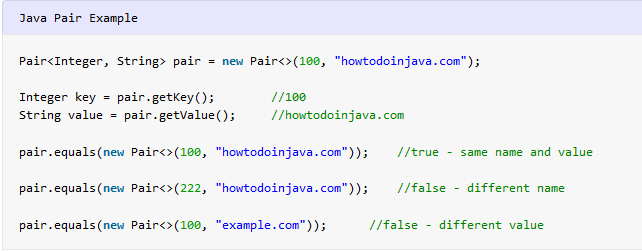Learn to work with key value pairs in Java using Pair classes e.g. javafx.util.Pair, ImmutablePair, MmutablePair (common langs) and io.vavr.Tuple2 class.
Read More : Tuples in Java
1. Why we need pairs?
A pair provide a convenient way of associating a simple key to value. In Java, maps are used to store key-value pairs. Maps store a collection of pairs and operate them as a whole.
Sometimes, we need to work on requirements where a key-value pair shall exist on it’s own. e.g.
- A pair need to be passed in a method as argument
- Method need to return two values in form of a pair
2. javafx.util.Pair class
Java core APIs have javafx.util.Pair as closest match which serve the purpose of having two values as name-value pair. Follow this link to learn to add JavaFx support in eclipse.
Pair class provides following methods.
boolean equals(Object o)– Test this Pair for equality with another Object.K getKey()– Gets the key for this pair.V getValue()– Gets the value for this pair.int hashCode()– Generate a hash code for this Pair.String toString()– String representation of this Pair.
Let’s see a java program to create and use pair.
Pair<Integer, String> pair = new Pair<>(100, "howtodoinjava.com"); Integer key = pair.getKey(); //100 String value = pair.getValue(); //howtodoinjava.com pair.equals(new Pair<>(100, "howtodoinjava.com")); //true - same name and value pair.equals(new Pair<>(222, "howtodoinjava.com")); //false - different name pair.equals(new Pair<>(100, "example.com")); //false - different value
3. Pair, ImmutablePair and MutablePair – Apache commons lang
Commons lang library has a useful class which can used as pair i.e. org.apache.commons.lang3.tuple.Pair. It has two subclasses which can also be used for same purpose i.e. ImmutablePair and MutablePair.
Pairclass is a pair consisting of two elements.Pairrefers to the elements as ‘left’ and ‘right’.Pairalso implements theMap.Entryinterface where the key is ‘left’ and the value is ‘right’.ImmutablePairis immutable representation onPair. If mutable objects are stored in the pair, then the pair itself effectively becomes mutable. The class is also notfinal, so a subclass could add undesirable behavior.ImmutablePairis thread-safe if the stored objects are thread-safe.
ImmutablePair<Integer, String> pair = ImmutablePair.of(100, "howtodoinjava.com"); Integer key = pair.getKey(); //100 String value = pair.getValue(); //howtodoinjava.com //Integer key = pair.getLeft(); //100 //String value = pair.getRight(); //howtodoinjava.com pair.equals(ImmutablePair.of(100, "howtodoinjava.com")); //true - same name and value pair.equals(ImmutablePair.of(222, "howtodoinjava.com")); //false - different name pair.equals(ImmutablePair.of(100, "example.com")); //false - different value
Do not forget to import the library into application classpath.
<dependency> <groupId>org.apache.commons</groupId> <artifactId>commons-lang3</artifactId> <version>3.8.1</version> </dependency>
4. io.vavr.Tuple2 – Vavr
Another useful class for storing key-value pair is Tuple2.
Tuple2 provide lots of useful method to work on data stored in it. e.g.
T1 _1()– Getter of the 1st element of this tuple.T2 _2()– Getter of the 2nd element of this tuple.Tuple2 update1(T1 value)– Sets the 1st element of this tuple to the given value.Tuple2 update2(T2 value)– Sets the 2nd element of this tuple to the given value.Map.Entry toEntry()– Converts the tuple tojava.util.Map.EntryTuple.Tuple2 swap()– Swaps the elements of this Tuple.Tuple2 map(BiFunction mapper)– Maps the components of this tuple using a mapper function.int compareTo(Tuple2 that)– Compare two Tuple2 instances.
Tuple2<Integer, String> pair = new Tuple2<>(100, "howtodoinjava.com"); Integer key = pair._1(); //100 String value = pair._2(); //howtodoinjava.com pair.equals(new Tuple2<>(100, "howtodoinjava.com")); //true - same name and value pair.equals(new Tuple2<>(222, "howtodoinjava.com")); //false - different name pair.equals(new Tuple2<>(100, "example.com")); //false - different value
Do not forget to import the library into application classpath.
<dependency> <groupId>io.vavr</groupId> <artifactId>vavr</artifactId> <version>0.10.2</version> </dependency>
Drop me your questions related to working with name-value pairs in Java.
Happy Learning !!


Comments